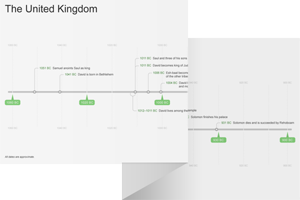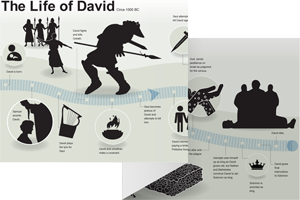1:1–16 Second Samuel |
1:1 the death of Saul See 1 Sam 31:4–5, 8–13.
defeating the Amalekites See 1 Sam 30:17–20.
Ziklag See 1 Sam 30: 1–6, 26.
1:2 clothes torn and with dirt on his head Traditional signs of mourning.
to David The narrative may provide details on David’s distance from the battle in order to avoid any implication that David had a part in Saul’s death. See note on 1 Sam 29:11.
had a part in Saul’s death. See note on 1 Sam 29:11.
bowed down See 1 Sam 24:8 and note.
1:4 How did things go ? David’s inquiry suggests that he anticipates a negative report. Given the words that follow, David is concerned about the lives of Saul and Jonathan.
and Jonathan.
1:5 How do you know Word of mouth will not suffice; he desires eyewitness details as further confirmation.
1:6 I merely happened to be The young man’s story conflicts with 1 Sam 31 at several points, including whether the young man killed Saul or Saul killed himself (1 Sam 31:4). The young man may be attempting to deliver what he believes will be good news to David for the sake of gaining a reward.
Mount Gilboa Though it appears that much of the battle took place there (1 Sam 31:1), the young man’s claim may be false.
1:8 I am an Amalekite Ironically, in this account Saul orders an Amalekite to kill him. Earlier, he disobeyed Yahweh by failing to kill the Amalekite king (see 1 Sam 15).
1:9 kill me First Samuel 31:4 indicates that Saul asked his armor bearer to kill him. Saul’s armor bearer also killed himself after seeing that Saul was dead (1 Sam 31:5).
1:10 crown The crown and the armband were symbols of kingship. If the Amalekite was lying in his account of Saul’s death, he may have taken these off Saul’s body after he was dead.
here, I have brought them The young man expects a reward; he does not anticipate David’s reaction or the fact that he would consider this to be bad news.
1:11 tore them A sign of mourning and extreme anguish.
 David Mourning in the Samuel Narratives
David Mourning in the Samuel Narratives
1:12 fasted In addition to being an act of religious devotion, fasting can also serve as a sign of mourning (compare Neh 1:4; Matt 9:15).
1:13 the son of an alien man Indicates he is a resident alien, a Gentile who was incorporated into the Israelite community (Lev 19:33–34). As a resident alien, he is under the same obligation as the rest of the members of the covenant community to honor Yahweh’s anointed. As an Amalekite, he is a sworn enemy of Israel (see 1 Sam 15).
1:14 destroy Yahweh’s anointed one See note on 1 Sam 23:26; 24:6 and note.
1:15 and he died David’s soldier kills the young man for killing Yahweh’s anointed. David may have been attempting to establish a precedent with regard to the treatment of Yahweh’s anointed, as well as making it clear that he had no hand in Saul’s death.
1:16 said to him, “Your blood is on your head The young man is guilty and must accept his punishment. He, not David, is responsible for his own death.
1:17–27 Rather than celebrating the death of his enemy, David composes a lamentation for Saul. David also mourns the loss of his dearest friend, Jonathan, his ally and confidant during these turbulent years. He remembers both men for their valor and strength in battle, identifying them as mighty men who accomplished great things for the nation of Israel. |
1:18 the scroll of Jashar A lost book, most likely a collection of Israelite poetry (compare Josh 10:13).
1:19 glory Refers to Saul and Jonathan.
how the mighty have fallen! The narrative repeats this refrain three times for emphasis (2 Sam 1:25, 27).
1:20 Do not tell it in Gath Gath and Ashkelon were two of the main cities of the Philistines (see note on 1 Sam 5:8). David cannot bear to think of Philistines celebrating Saul’s death.
the uncircumcised See 1 Sam 14:6 and note.
1:21 O mountains of Gilboa The location where Saul and Jonathan were slain (1 Sam 31:1).
1:24 the one who clothed you with crimson Saul’s reign appears to have been a time of economic success and prosperity for Israel.
1:26 your love was more wonderful to me than See note on 2 Sam 1:17–27; 1 Sam 18:1 and note.

|
About Faithlife Study BibleFaithlife Study Bible (FSB) is your guide to the ancient world of the Old and New Testaments, with study notes and articles that draw from a wide range of academic research. FSB helps you learn how to think about interpretation methods and issues so that you can gain a deeper understanding of the text. |
| Copyright |
Copyright 2012 Logos Bible Software. |
| Support Info | fsb |
 Loading…
Loading…


